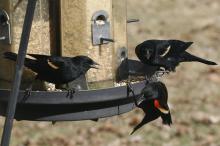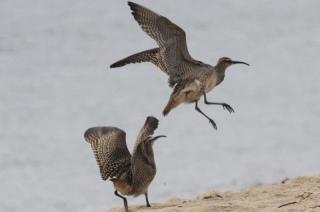Birds
2013
A warbler seen in the Phillips Preserve and a thrush spotted in the Gay Head Moraine are members of groups of birds I have always had trouble distinguishing between. The Connecticut warbler is one of three warblers that are tough to separate. The other two are the Nashville warbler and the mourning warbler. The MacGillivray’s warbler is also a look-alike, but is a western species never seen on the Vineyard and, to my knowledge, only five times in Massachusetts. The last time was in 2009 in Boston.
We were packing to leave for a trip to Maine on Sept. 14 to visit old Vineyard friends and attend a wedding. Our backpacks were on the kitchen table and I had just filled the hummingbird feeder. One of the juvenile ruby-throated hummingbirds flew up to the kitchen window, hovered for a few seconds and then flew off. That was the last time we saw our hummingbirds.
Hummingbirds are surprisingly abundant for mid September. A request for information sent out yesterday generated 19 responses, 14 of which still had either females or immatures at their feeders on Sept. 16. Wow! I did not expect that many responses. Charlie Kernick was the only one to report that a male was still present, so the males have apparently left already. The other five responses had observed hummers either last week or over the weekend. Thanks to all the respondents; there are too many names to list them all.
On Sept. 7 Tim Spahr, an excellent birder from the mainland, was birding with Allan Keith in the Gay Head Moraine. They were on a small bridge over a trickling stream when Tim heard a chip note that Tim said was a hooded warbler. Allan Keith and I both have difficulty hearing and identifying chip notes so we are always willing to bird with someone with good ears. Allan was stunned that Tim not only heard the note, but identified it. With a little coaxing the bird came closer and Tim was able to photograph an immature female hooded warbler.
In 1974 my brother in law, Brian Harrington, while working at the Manomet Center for Conservation Sciences, developed International Shorebird Surveys to “gather basic migration information on shorebirds and the wetlands they use.” Later the Atlantic Canada Shorebird Survey joined in and the data collected by huge numbers of volunteers from both organizations showed that many species of shorebirds depend on flats and other wetland habitats to fuel up on food as they often move up to 11,000 miles per year.
The tide is changing for the bird population. The summer residents are slowly departing and other species are arriving to fill that niche. The most obvious difference for beachgoers is the terns. Where there were a good number of terns in early August, there are just a few lingering souls. The smallest of our nesting tern species, the least tern, is extensively gone, headed for Florida and points south. There are many fewer common and roseate terns loafing on the flats and beaches.







